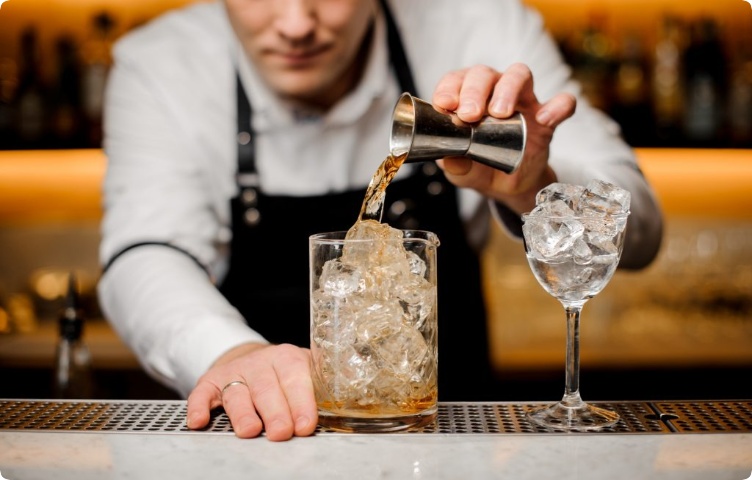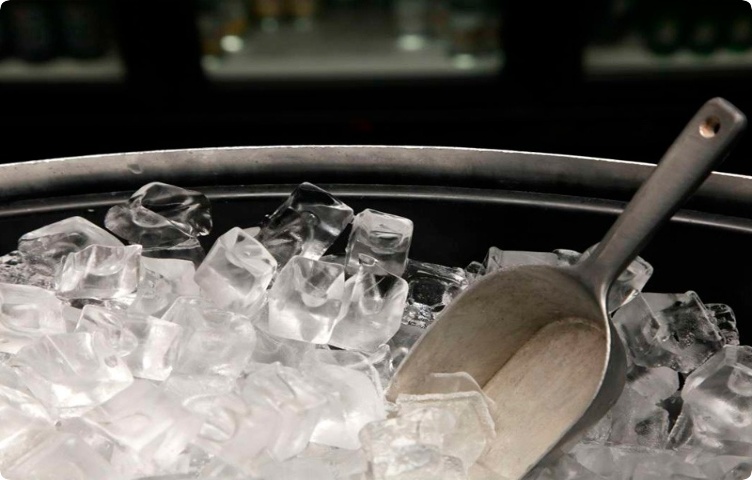To prepare cocktails, serve wines and desserts in catering establishments, a large amount of edible ice is required. To regularly replenish its reserves, a special machine is used - an ice generator . Choosing this equipment is not easy - you need to understand the types of device, know its functions, power and configuration. Our recommendations will help you find a model that is suitable for a restaurant, cafe or bar.
Key Factors in Choosing the Best Ice Maker for Your Business Needs
When purchasing an ice making machine, you need to consider the nature and needs of the business. The cooling product has many uses including:
- transportation and storage of raw products (vegetables, fruits, fish and seafood);
- preparing cold drinks;
- creating desserts containing crushed ice;
- cooling of raw products;
- decorating display cases with fruit salads, fresh juices, seafood;
- design of buffets and food courts.

These tasks require different volumes of ice - from 5 kg in a small bar to hundreds of kilograms when transporting seafood delicacies. To calculate the average cost for your establishment, divide the weekly costs by 7 days and multiply by 1.2. The last number is a safety factor that takes into account fluctuations in demand.
The second factor that should be taken into account is the hygienic safety requirements of the product. Choose an ice maker that produces the quality product you require.
Take into account the location of household communications in your establishment. There must be an electrical outlet near the device. Many models connect directly to the water supply and require access to ventilation.
Types of Ice Makers
Ice making machines vary in installation method, cooling system and water supply. The most accurate classification is considered to be based on the type of product the device produces.
There are three main types of device:
cube - freezes water in the form of cubes with a side length of 1.5 to 3 cm. The internal mechanism automatically supplies water to the mold. Once frozen, the mold moves to the front of the machine and releases the finished cubes;
scaly - produces thin, unevenly shaped ice sheets. Freezing technology is based on uniform spraying of water onto the drum. At temperatures from −7 to −9 °C, water turns into scales 0.5-2 mm thick;
granular - forms flaky ice by accelerated freezing, then crushes it into small granules.
There are also varieties of generators that produce ice “fingers” and “cones”. They work on the same principle as cube ones. The latest technology is the production of soft ice that can be chewed.
Selection by parameters
The first thing that an ice maker must match is the character and scale of your establishment. If this is a bar where a lot of cocktails are prepared, you will need a professional high-power machine. For a cafe-patisserie, you can purchase a compact ice maker.
Explore four more options:
- size - determines how many products the machine can produce and the area it will occupy in the room. Sizes can range from miniature tabletop models to commercial equipment;
- drainage system - an internal mechanism that removes the remaining melt water. Make sure that the device is equipped with a high-quality drainage system in the form of a pipe or drainage above the floor;
- location - it is important to check whether the installation of the generator requires a connection to the ventilation or drainage line. Also consider where to install the equipment - on an open terrace, behind the bar or in the kitchen. Keep in mind that there must be access to a water supply nearby;
- style - the appearance of the generator should be combined with the interior of the establishment. There are models with a panel facade, which can be easily matched to the furniture design. The machine with a shiny stainless steel body will suit any room.
If you are buying an ice maker for the first time, rely on highly rated manufacturers. Products from the brands Gorenje Bomann, Caso, and ProfiCook deserve good customer reviews.

Ice Shape
Bar etiquette involves serving drinks with different types of ice additives. The most common forms:
- cubes are a classic option, suitable for mixing cocktails, cooling fresh food, filling champagne buckets. Dolit does not melt, so it is popular in bars and fast food establishments;
- fingers - are narrow cylinders with a recess inside. Cools liquid faster than cubes. Used for preparing cold drinks;
- cones - made in the form of short cylinders with a thickening at the end. Melts slowly, keeping the liquid cool for a long time. Usually added to carbonated drinks, iced tea;
- scales - looks like thin plates that do not have a strict shape. It has the lowest temperature, thanks to which it does not melt for a long time. Used for cooling raw products, display windows;
- granules - ice grains with a diameter of 5-10 mm. Suitable for transporting products, as well as for any culinary purposes - preparing desserts, mixing cocktails, designing display cases.
Professional equipment is equipped with options for the production of ice products of various sizes.

Performance
The volume of product that a machine produces per day depends on its type and size. A tabletop generator produces 5 to 15 kg of ice in 24 hours. But these products usually come with small containers, so they have to be emptied frequently. This option is inconvenient for bars with a large influx of visitors.
Large food service establishments, hotels and catering systems typically use commercial ice machines that can operate continuously for 10-12 hours a day, producing 25 to 50 kg. Such equipment is equipped with containers up to 25 kg.
Cooling system
The operation of the ice maker is directly related to the condensation method. There are three types of capacitors:
water cooling - is a tube through which tap water moves. Cools effectively, regardless of ambient temperature. Generators with such a system must be installed near a water supply. A prerequisite is water filtration. Water-cooled equipment consumes little electricity and does not create much noise. But only a specialist can clean the ice maker;
air cooling - produced by ventilation. Allows you to reduce water consumption and does not require the installation of water purifiers, therefore it is recommended for establishments that do not have stable water pressure. You can clean the device yourself. But an air-cooled generator consumes more electricity. When installing, you need to make sure that there is plenty of free space nearby for air circulation;
split system - removes the heat generated during operation of the device outside the building. Does not create a load on ventilation and air conditioning, produces 75% less noise than other capacitors. But running lines to a distant location requires additional costs.
In large enterprises where a lot of ice is required daily, it is more profitable to use equipment with a water system. In a small catering establishment where there is no quality water, an air system will be more effective.
Completeness
When choosing an ice maker, check to see if an ice bin is included. Built-in models are usually equipped with containers with a volume of 15-25 kg. The full-width door of the facade makes it easy to remove the container. For hotels, restaurants and other establishments where ice comes into direct contact with food, equipment with a sealed container is recommended. An ice cube scoop will also be a convenient addition to the kit.
Installation method
An important factor in choosing an ice maker is the location and need for installation. There are three device options:
- built-in - designed for installation under a countertop or in a cabinet. This option allows you to save work space. The machine has a container with a capacity of 10-25 kg. The built-in equipment has great power, so it is suitable for catering establishments. Installation requires a water connection;
- autonomous - installed on the floor in any part of the room where there is access to water supply. They are not inferior in size and power to built-in models. They can produce 10-25 kg of products per day. Equipped with an ice container. They take up part of the working space, so they are not recommended for small bars;
- desktop - characterized by compact size and low productivity, from 5 to 15 kg per day. This model is easy to clean and can be taken to outdoor events. No water connection is required as the device is refilled manually. The product can be installed on a table or bar counter, and put away for storage between uses. A tabletop generator is considered the best option for a small baror house parties.
An ice maker is not required for everyday use at home. It is replaced by a set for preparing cubes, which is placed in the freezer of the refrigerator.
Water supply method
Catering establishments usually use generators with running water supply. They are filled directly from the water supply. To obtain edible ice that meets hygienic standards, you need to install types and hardness softeners or buy an ice maker with a built-in filter.
Tabletop devices operate on a flooding system. Water comes from a special container, which is filled manually.
















































/https%3A%2F%2Fcomplexbar.com%2Fimages%2Fblog%2F244%2Fled_glavn.jpg)
/https%3A%2F%2Fcomplexbar.com%2Fimages%2Fblog%2F246%2Fsirop_scale_2400.jpeg)
/https%3A%2F%2Fcomplexbar.com%2Fimages%2Fblog%2F246%2Fkofe-vostochniy.jpg)
/https%3A%2F%2Fcomplexbar.com%2Fimages%2Fblog%2F245%2Fpexels-jason-villanueva-851555.jpg)
/https%3A%2F%2Fcomplexbar.com%2Fimages%2Fblog%2F246%2F2024-04-09_17.22.54.jpg)
/https%3A%2F%2Fcomplexbar.com%2Fimages%2Fblog%2F246%2F2024-04-09_17.22.47.jpg)
/https%3A%2F%2Fcomplexbar.com%2Fimages%2Fblog%2F246%2FCODE_anons_foamydrops_752%D1%85480_eng.jpg)
/https%3A%2F%2Fcomplexbar.com%2Fimages%2Fblog%2F246%2FAlina_752%D1%85480_eng.jpg)
/https%3A%2F%2Fcomplexbar.com%2Fimages%2Fblog%2F246%2F2024-04-09_17.23.22.jpg)
/https%3A%2F%2Fcomplexbar.com%2Fimages%2Fblog%2F246%2F2024-04-09_17.23.28.jpg)
/https%3A%2F%2Fcomplexbar.com%2Fimages%2Fblog%2F246%2F2024-04-09_17.23.35.jpg)
/https%3A%2F%2Fcomplexbar.com%2Fimages%2Fblog%2F246%2Fdrinksome_752%D1%85480_eng.jpg)
/https%3A%2F%2Fcomplexbar.com%2Fimages%2Fblog%2F246%2Fnude_752%D1%85480_eng.jpg)
/https%3A%2F%2Fcomplexbar.com%2Fimages%2Fblog%2F246%2F752%D1%85480_eng__1_.jpg)
/https%3A%2F%2Fcomplexbar.com%2Fimages%2Fblog%2F246%2F752%D1%85480_eng.jpg)
/https%3A%2F%2Fcomplexbar.com%2Fimages%2Fblog%2F246%2FStudioRaw_752%D1%85480_eng.jpg)
/https%3A%2F%2Fcomplexbar.com%2Fimages%2Fblog%2F246%2FDoppio_tea_752%D1%85480_eng.jpg)
/https%3A%2F%2Fcomplexbar.com%2Fimages%2Fblog%2F246%2FTognana_Stars_Stripes_752%D1%85480_eng.jpg)
/https%3A%2F%2Fcomplexbar.com%2Fimages%2Fblog%2F246%2FRona_752%D1%85480_eng.jpg)
/https%3A%2F%2Fcomplexbar.com%2Fimages%2Fblog%2F246%2FDoppio_vending_752%D1%85480_eng.jpg)
/https%3A%2F%2Fcomplexbar.com%2Fimages%2Fblog%2F246%2FEssence_sukhie_smesi_752%D1%85480_eng.jpg)
/https%3A%2F%2Fcomplexbar.com%2Fimages%2Fblog%2F246%2FODK_sukhie_smesi752%D1%85480_eng.jpg)
/https%3A%2F%2Fcomplexbar.com%2Fimages%2Fblog%2F246%2Funiforma-barmena.jpg)
/https%3A%2F%2Fcomplexbar.com%2Fimages%2Fblog%2F246%2Fkak-nanyat-barmena.jpg)
/https%3A%2F%2Fcomplexbar.com%2Fimages%2Fblog%2F246%2Fsirop_scale_2400.jpeg)
/https%3A%2F%2Fcomplexbar.com%2Fimages%2Fblog%2F246%2FPeugeot_Anons_Paris_U%27Select_Line_Daman_752%D1%85480_eng.jpg)
/https%3A%2F%2Fcomplexbar.com%2Fimages%2Fblog%2F246%2Fkofe-vostochniy.jpg)
/https%3A%2F%2Fcomplexbar.com%2Fimages%2Fblog%2F246%2FMadler.jpg)
/https%3A%2F%2Fcomplexbar.com%2Fimages%2Fblog%2F246%2Fprofbartender_glavn.jpeg)